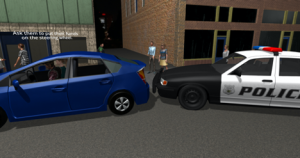
The ability to train employees with more visually stimulating and memorable materials will have a significant impact on the effectiveness of the training. Research suggests that VR is a particularly effective tool for training that requires memorizing and understanding spatial and visual information, as well as for eliciting effective responses to stressful or difficult situations.
Conversely, traditional classroom training can have limited effectiveness for many segments of employees. It tends to be relatively passive, and many employees neither enjoy the experience nor retain much of the content that is presented. Fortunately, the virtual reality (VR) methods that have long been used to train airline pilots and astronauts are starting to make their way into corporate training as well.
Early VR training programs were often little more than 360-degree videos demonstrating the use of new equipment or the elements of an assembly process. It was passive learning, although immersive headsets were better at holding their attention. Fast forward to today and we see that technology improvements in headsets and content development platforms have dramatically lowered the cost of VR training. The growth trajectory has been further boosted by the pandemic which has forced many training sessions to be remote or socially distant – making virtual not only a nice-to-have option, but a mandatory shift to maintain safety as well as business continuity. As the technology continues to improve, the many benefits of VR training will make it a pervasive option for a wider variety of training programs.
Interactive experiential training
One of the key reasons that modern VR training is so effective is its ability to provide truly interactive experiences that are reality-based with role-playing. By experiencing real-world scenarios that include challenging interpersonal interactions, complex decision making, or emergency, high-stress situations, trainees develop a mastery that is difficult to achieve in classroom-based training. Each scenario plays out differently depending on the participant’s real-time decision-making. The consequences of a good or bad decision are immediately apparent.
Repetition is a proven learning tool for role-based scenarios. This can be costly for organizations to deliver with live role-playing, but variations of the VR scenario can be repeated at a minimal cost to the organization. VR training can also be scored much like a video game, engaging the trainee by providing additional motivation for increased engagement in the role play.
By adding motion capture to VR training, employees have the ability to interact with their colleagues and physical objects in a virtual space. This is accomplished by adding motion-tracking cameras to the training studio to track the location of people and objects in that space using a very high frame rate. The virtual experience then has the ability to show relative location with no perceptual lag. This allows employees to work collaboratively on tasks like handing tools to each other. The motion tracking can also measure whether employees are observing social distancing requirements, and can monitor their body posture as they work on equipment or lift objects, providing real-time feedback to help avoid accidents or injuries.
Procedural training and digital twins
Virtual models or digital twins of machinery, assembly lines, workplaces, or job sites can be safe and cost-effective options for practicing routine operations, start up and shutdown procedures, and responses to abnormal instrument readings. This can be particularly helpful for new employee training or introducing new processes and procedures. Digital twins are also a great way to review infrequently performed safety protocol for things like emergency shut down procedures – allowing employees to review required actions without an interruption to daily activities. VR procedural training can also be useful in preparing employee teams on processes in remote locations or hazardous environments before they actually go on site. Examples include oil drilling platforms or nuclear processing facilities.
Effective safety training is extremely important in many process industries. VR training using digital twins allows employees to experience virtual events that could present a safety risk in real life and allow the trainee to build “muscle memory” of how to respond when it may be difficult or hazardous to practice on actual equipment. For example, a large part of airline simulator training allows pilots to safely experience how to handle engine failures or extreme weather conditions.

Scenario training
It can be very valuable for employees to role-play scenarios that require individuals or small teams to respond immediately to a situation that is challenging or potentially hazardous. Examples include preparing an employee to manage upset customers, equipping a human resources manager to handle a sensitive discussion, or training a team of police officers on de-escalation techniques for angry crowds. Responders can experience triaging a large accident site collaboratively. An operating room team can practice scenarios for a complex operation. The ability to safely experience and fail in these scenarios has a lasting impact on skills training that the classroom cannot provide.
Scenario training also provides real-time feedback in an immersive environment by changing the trainees’ experience based on their decision-making and actions. This can be part of a set of scenario trees within the training application that is triggered by an action or voice response, as well as in real-time by the trainer. The individual or team immediately sees the results of their decisions: The customer storms off or the patient dies if the wrong decisions are made. The scenario can be repeated to build proficiency, with the trainer introducing unexpected events each time.

Virtual reality training economics
Until recently, creating virtual reality procedural or scenario training was quite expensive. The content was developed like video production, at a cost that was typically several thousand dollars per minute. New hybrid development platforms now incorporate game engine technology with low code visual editors and connectors to existing enterprise systems. This dramatically improves the economics of producing VR training by providing pre-built modules and other tools designed specifically for developing training scenarios. This approach also gives much more control of content development to the key constituents in the workplace vs. outside production professionals. It also provides much greater flexibility to create a variety of real-time feedback and scenario branching. The result is the much lower cost of production and flexibility to create VR learning content customized for small groups.
The immersive experience of VR training, combined with interactive programs that can be practiced until mastery is achieved, typically leads to much better learning outcomes. This increased efficiency and high level of employee engagement are encouraging much broader adoption for a wider variety of applications.




